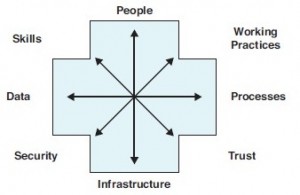Organizations must respond to changes in their internal and external environment in order to survive. The term ‘morphing organization’ is used to reflect that although the organization changes, some elements of the organization need to remain the same to maintain the organization’s identity. As an organization changes, the context in which information is managed also changes.
Definition of a Morphing Organization
“A morphing organization is an organization that gradually changes the external image it presents to the world while retaining its own identity” (Cox, 2014, p.17)
Organizations present an external face to its customers. Beneath the face, physical structures and business processes operate to maintain the image presented. These structures and processes are changed to modify or transform the operation of the organization, depending on the degree of change required.
Morphing Dimensions
Figure 1 shows the main dimensions that can be used to analyse the way in which an organization has morphed over time.
Infrastructure is used here as a broad term to include physical infrastructure and IT infrastructure, depending on the nature of the change. For example, an organization may change its physical premises or store layout, which affect the way in which the customer engages with staff in the organization. Alternatively, an organization may change its IT infrastructure which may not make a visible change to the organization’s external face, but may affect the organization’s ability to respond to customer demands.
Processes refer to the way in which the organization performs the activities required to both directly interact with customers and the back-office activities to ensure the smooth running of the organization.
Security refers to the change to risks of products, processes, people and data in the organization.
Trust considers whether a specific form of change, changes the balance of power in trading relationships. For example, physical retailers trust that customers will pay for items before leaving the store, whereas online customers trust that the retailer will accurately deliver a purchase as agreed.
The practice dimension considers how activities are performed by both staff and customers.
The people dimension recognizes that as practices and processes change, the job roles and expertise required by the organization may change.
Skills also recognizes that changes to job roles, processes and practices may mean that different skill sets are required to perform the activities in the organization.
Changes to any of the dimensions may affect the type, range or characteristic of the data that need to be captured to meet the needs of the organization. Changes to the data to be captured and managed in the organization, may require changes to be made to the process or practices to capture and manage the data.
Impact on Information Management
Change to one of the morphing dimensions shown in Figure 1 may trigger changes to other dimensions, which can impact on information management in the morphing organization. For example, changes to the technological infrastructure may introduce additional security risks to the information resource and information may be needed to monitor security. Changes to the infrastructure may also increase the touchpoints in the organization where data are captured, increasing the risk that data may be captured incorrectly or inconsistently. Business processes and practices may be changed to capture the data using different technology at the touchpoints. This may require a change to staffing arrangements to conduct the changed processes, which may require different skills to be acquired in the organization.
Morphing organizations have to change to survive, however, it is important to consider how changes to one morphing dimension affect other areas of the organization architecture. The organization architecture is discussed here:(http://www.managinginformation.org/what-is-an-organization-architecture The impact of changes to the organization architecture on information management also needs to be considered when assessing the organizational transformation required in morphing organizations.
Further Reading: Examples of how morphing dimensions are used to analyse change are presented in Chapter 1.

